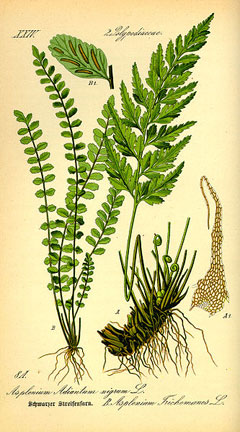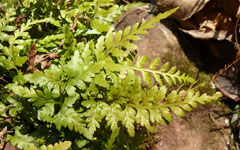 |
|
http://commons.wikimedia.org/wiki/File:Illustration_Asplenium_trichomanes0.jpg |
 |
| http://commons.wikimedia.org/wiki/User:BerndH |
Translate this page:
Summary
Physical Characteristics

 Asplenium adiantum-nigrum is an evergreen Fern growing to 0.5 m (1ft 8in).
Asplenium adiantum-nigrum is an evergreen Fern growing to 0.5 m (1ft 8in).
See above for USDA hardiness. It is hardy to UK zone 6. It is in leaf all year, and the seeds ripen from June to October.
Suitable for: light (sandy) and medium (loamy) soils and prefers well-drained soil. Suitable pH: mildly acid, neutral and basic (mildly alkaline) soils. It can grow in full shade (deep woodland) or semi-shade (light woodland). It prefers moist soil.
UK Hardiness Map
US Hardiness Map
Synonyms
Plant Habitats
Woodland Garden Dappled Shade; Shady Edge; not Deep Shade; Hedgerow; North Wall. In.
Edible Uses
References More on Edible Uses
Medicinal Uses
Plants For A Future can not take any responsibility for any adverse effects from the use of plants. Always seek advice from a professional before using a plant medicinally.
Bitter Contraceptive Diuretic Emmenagogue Expectorant Laxative Ophthalmic Pectoral
The plant is bitter, diuretic, laxative and ophthalmic[240]. It is taken internally to treat diseases of the spleen, jaundice and ophthalmia[240]. It is said to produce sterility in women[240]. A decoction or syrup made from the fronds is emmenagogue, expectorant and pectoral[240]. It is used to relieve troublesome coughs[4].
References More on Medicinal Uses
The Bookshop: Edible Plant Books
Our Latest books on Perennial Plants For Food Forests and Permaculture Gardens in paperback or digital formats.

Edible Tropical Plants
Food Forest Plants for Hotter Conditions: 250+ Plants For Tropical Food Forests & Permaculture Gardens.
More

Edible Temperate Plants
Plants for Your Food Forest: 500 Plants for Temperate Food Forests & Permaculture Gardens.
More

More Books
PFAF have eight books available in paperback and digital formats. Browse the shop for more information.
Shop Now
Other Uses
Hair
A decoction of the herb is a good hair wash[17].
Special Uses
References More on Other Uses
Cultivation details
Requires a partly shaded site with preferably less than 3 hours sunshine daily[200]. Plants can be grown in old brick walls[219]. Members of this genus are rarely if ever troubled by browsing deer[233].
References Carbon Farming Information and Carbon Sequestration Information
Temperature Converter
Type a value in the Celsius field to convert the value to Fahrenheit:
Fahrenheit:
The PFAF Bookshop
Plants For A Future have a number of books available in paperback and digital form. Book titles include Edible Plants, Edible Perennials, Edible Trees,Edible Shrubs, Woodland Gardening, and Temperate Food Forest Plants. Our new book is Food Forest Plants For Hotter Conditions (Tropical and Sub-Tropical).
Shop Now
Plant Propagation
Spores - best sown as soon as they are ripe on the surface of a humus-rich sterilized soil. Keep the compost moist, preferably by putting a plastic bag over the pot. Germinates in spring[1]. Spring sown spores germinate in 1 - 3 months at 15°c[134]. Pot on small clumps of plantlets as soon as they are large enough to handle and grow them on in light shade in a cold frame or greenhouse. Keep them humid until they are well established. When they are at least 15cm tall, plant them out into their permanent positions in late spring or early summer.
Other Names
If available other names are mentioned here
Native Range
TEMPERATE ASIA: Cyprus, Egypt (Sinai), Israel, Jordan, Lebanon, Syria, Turkey, Russian Federation-Ciscaucasia (Ciscaucasia), Azerbaijan, Georgia, Russian Federation (Dagestan), Kyrgyzstan NORTHERN AMERICA: United States (Colorado, Arizona, Utah), Mexico (Chihuahua) EUROPE: Denmark, United Kingdom, Ireland, Norway, Sweden, Austria, Belgium, Switzerland, Czech Republic, Germany, Hungary, Netherlands, Poland, Slovakia, Ukraine (incl. Krym), Albania, Bulgaria, Bosnia and Herzegovina, Greece, Croatia, Italy (incl. Sardinia), North Macedonia, Montenegro, Romania, Serbia, Slovenia, Spain, France (incl. Corsica), Portugal AFRICA: Spain (Canarias), Portugal (Azores, Madeira Islands), Algeria, Egypt, Libya, Morocco, Tunisia, Lesotho, South Africa (KwaZulu-Natal, Free State, Eastern Cape, Northern Cape, Western Cape, Gauteng, Limpopo, Mpumalanga)
Weed Potential
Right plant wrong place. We are currently updating this section.
Please note that a plant may be invasive in one area but may not in your area so it's worth checking.
Conservation Status
IUCN Red List of Threatened Plants Status :

| Related Plants
|
| Latin Name | Common Name | Habit | Height | Hardiness | Growth | Soil | Shade | Moisture | Edible | Medicinal | Other |
| Asplenium bulbiferum | Hen And Chicken Fern, Parsley Fern, Mother Spleenwort | Fern | 0.3 |
10-11
| S | LMH | SN | M | 1 | 0 | |
| Asplenium ceterach | Scale Fern | Fern | 0.2 |
7-10
| M | LM | FSN | M | 0 | 2 | 2 |
| Asplenium ruta-muraria | Wall Rue, Lance asplenium | Fern | 0.1 |
5-9
| S | LM | S | M | 0 | 2 | |
| Asplenium scolopendrium | Hart's Tongue Fern | Fern | 0.6 |
4-8
| S | LM | FS | DM | 0 | 2 | 3 |
| Asplenium trichomanes | Maidenhair Spleenwort, Dense spleenwort, Toothed spleenwort, Brightgreen spleenwort | Fern | 0.4 |
5-9
| M | LM | FS | M | 1 | 1 | 2 |
| Athyrium filix-femina | Lady Fern, Common ladyfern, Subarctic ladyfern, Asplenium ladyfern, Southern Lady Fern, Tatting Fer | Fern | 0.6 |
3-8
| M | LMH | FS | M | 1 | 2 | 2 |
|
Growth: S = slow M = medium F = fast. Soil: L = light (sandy) M = medium H = heavy (clay). pH: A = acid N = neutral B = basic (alkaline). Shade: F = full shade S = semi-shade N = no shade. Moisture: D = dry M = Moist We = wet Wa = water.
Now available:
Food Forest Plants for Mediterranean Conditions
350+ Perennial Plants For Mediterranean and Drier Food Forests and Permaculture Gardens.
[Paperback and eBook]
This is the third in Plants For A Future's series of plant guides for food forests tailored to
specific climate zones. Following volumes on temperate and tropical ecosystems, this book focuses
on species suited to Mediterranean conditions—regions with hot, dry summers and cool, wet winters,
often facing the added challenge of climate change.
Read More
Expert comment
Author
L.
Botanical References
17200
Links / References
For a list of references used on this page please go here
Readers comment
| Add a comment |
|
If you have important information about this plant that may help other users please add a comment or link below. Only comments or links that are felt to be directly relevant to a plant will be included. If you think a comment/link or information contained on this page is inaccurate or misleading we would welcome your feedback at [email protected]. If you have questions about a plant please use the Forum on this website as we do not have the resources to answer questions ourselves.
* Please note: the comments by website users are not necessarily those held by PFAF and may give misleading or inaccurate information.
To leave a comment please Register or login here All comments need to be approved so will not appear immediately.
|
Subject : Asplenium adiantum-nigrum
|
|
|
|